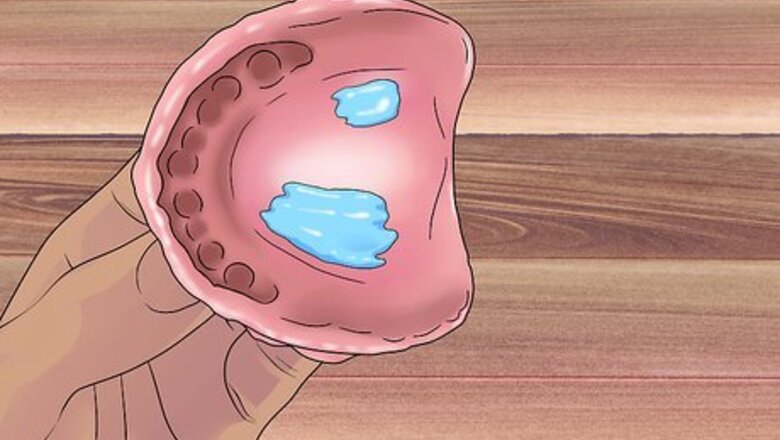
views
Loosening Denture Adhesive
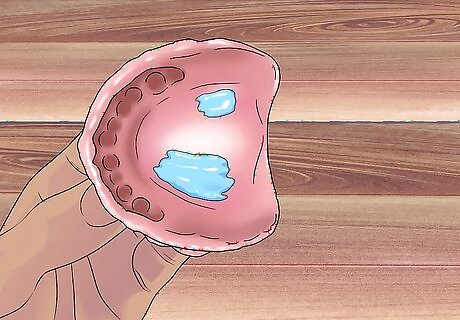
Allow your denture adhesive to loosen naturally. Denture adhesive loosens naturally in the presence of water or moisture. As a result, most denture adhesives contain a substance that absorbs saliva in order to prevent the moisture in your mouth from loosening the adhesive. This works for most of the day, but eventually loses its capacity to absorb any more saliva. At this point, your denture adhesive will naturally start to loosen. You should ideally be able to remove your dentures easily with no adhesive remaining on your gums, and only some adhesive left on the dentures themselves (which can be subsequently cleaned).
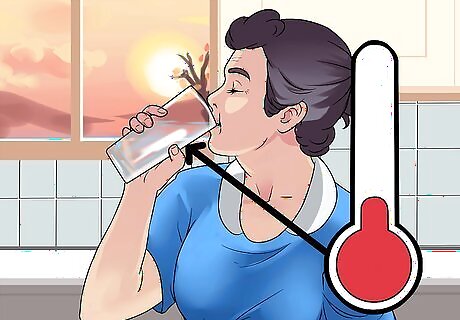
Use water to loosen the adhesive further. If you find that your denture adhesive does not loosen enough on its own throughout the day, you can rinse your mouth with warm water. Before you place the water in your mouth, ensure that you can tolerate the temperature and that it is not too hot. Take a sip of the water and swish it around in your mouth for 30 seconds to one minute. The longer you hold it in your mouth, the more it will help to loosen the adhesive from your gum surfaces. After a minute spit it out into the sink. Repeat this same procedure a couple of times and most of the adhesives will be washed away.
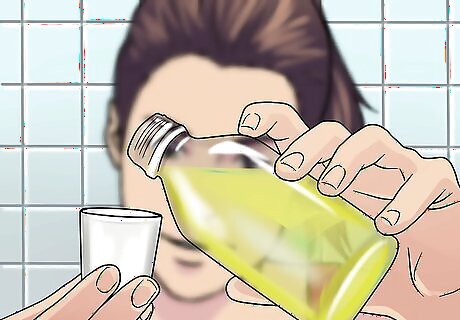
Try using mouthwash. Another option instead of water is to use a mouthwash such as Crest Pro-Health. The moisture from the mouthwash can serve to loosen your denture adhesive, while providing you with fresh breath at the same time. You can also use a mixture of salt and water by creating a saline solution to rinse your mouth before taking off your denture. Simply mix about half spoonful of salt into a glass of water for two minutes or until is completely dissolved.
Removing Your Dentures and Cleaning Your Gums
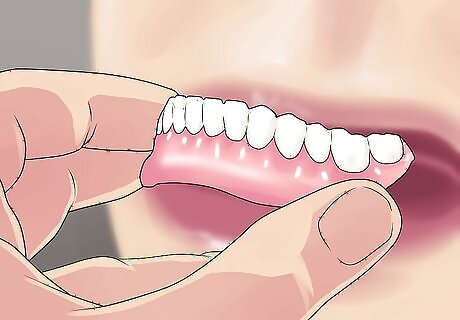
Learn how to effectively remove your dentures. Remove your lower dentures first by gripping them between your thumb and your fingers and using a gentle rocking motion from side-to-side. The lower dentures should come out easily without needing much force. Your upper dentures may be slightly more challenging to remove. Use your thumbs to press your front dentures upwards and outwards in the direction of your nose. You can also pull them by placing your index fingers on the sides. If you manage to let air pass between your dentures and the soft mucosa, then they will fall off easily. The highest suction is found in the back of your dentures where the border with the soft palate is found, so when removing them try to go as far back as you can. If you have challenges removing your dentures, stop by your dentist's office for advice and guidance. A dental assistant will likely be able to help you, or the receptionist may even have advice that improves your technique and helps you to get your dentures out.
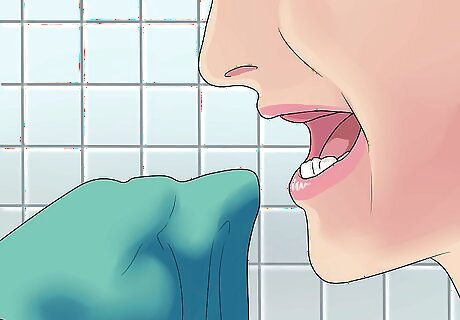
Use a washcloth to clean your gums once your dentures are removed. If any adhesive remains on your gums after your dentures have been removed, you can easily get rid of this using a warm washcloth. Gently wet the cloth and rub it in gentle circular motions over your gums to clear off any remaining adhesive.
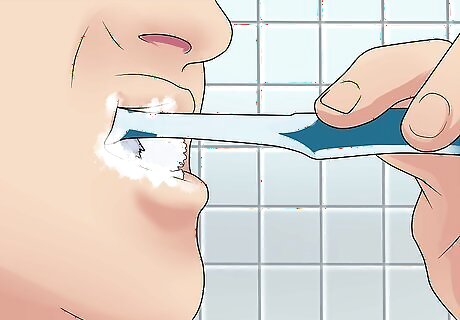
Try using a toothbrush. Alternatively, you can use a toothbrush to remove any remaining adhesive from your gums. Place a pea-sized amount of toothpaste on your brush and proceed to gently brush your gums with it. This serves both to remove any remaining adhesive, and also to promote optimum gum health. Cleaning and brushing your gums daily is recommended as part of good oral hygiene.
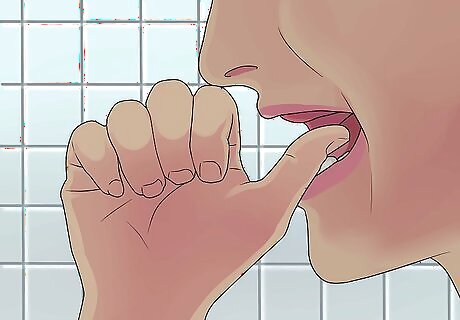
Use your fingertips. Once your dentures are out, rather than using a washcloth or a toothbrush, you can simply use the tip to massage the roof of your mouth and other gum surfaces that hold the dentures in place. Use a firm and circular motion as it helps to remove the adhesive from the gums. Rinse your mouth out and, if needed, massage your gums more than once to ensure your gums are completely adhesive free. Massaging your gums also increases the blood circulation to the gums and keeps them healthy. Take care not to hurt your gums with your fingernails! If you have long nails, you'll be better off with a different method. Finally able to try adhesive without dreading removal. "I avoided denture adhesive because I gagged trying to scrub it out. Reading these gentle loosening and cleaning methods gives me the confidence to try it again. Now my dentures don't shift when I laugh!" - Ira A. Insight for a future denture-wearer. "After full tooth extraction, I anxiously await my new dentures. This article taught me excellent hygiene techniques for using adhesive properly. I especially appreciated the tips on amount to use and cleaning gums safely during healing." - Beverly J. Clarified removal techniques during a sensitive healing period. "Just 2 weeks post-surgery, I have stitches limiting my gum cleaning. Trying to scrub off adhesive sent me into a 15-minute battle. This article explained safe options for my tender mouth. I wish my dentist had covered usage amounts and removal like this beforehand!" - Anne M. Gave me confidence to try adhesive for the first time. "Wanting to stabilize my lower denture, I considered adhesive but wasn't instructed on usage or removal. Before trying it out, I read this guide to learn proper application and cleaning methods. Now I can test adhesive without anxiety about being unable to remove it later!" - Nadine L. Reassurance that leftover adhesive is normal. "As a new denture-wearer, I was concerned to see adhesive stuck to my gums after removal. This clearly explained it's normal and provided multiple safe cleaning techniques. That insight brought me great comfort!" - Judy B. Have a story our readers should hear? Share it with 1 billion+ annual wikiHow users. Tell us your story here.
Applying Denture Adhesive
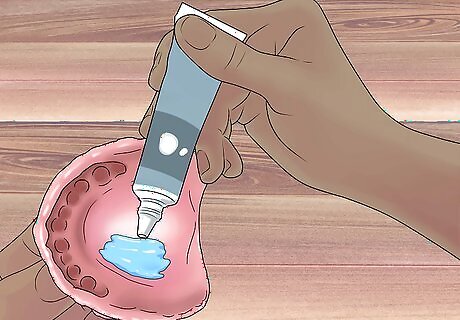
Use a cream denture adhesive. To apply a cream denture adhesive, it is generally recommended to dab three to four small circles of cream (approximately the size of a pencil eraser) on both your upper and lower dentures prior to inserting them in your mouth. Do not use more than this if you want to be able to easily remove your dentures later. You know you used too much if excess cream drips off your dentures after you have inserted them.
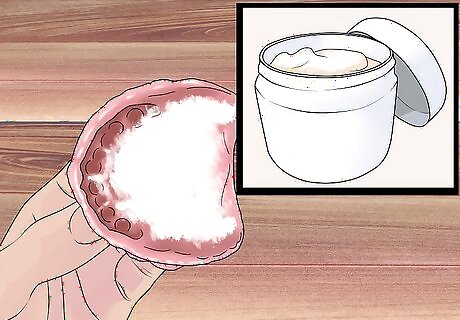
Try a powder denture adhesive. Another option is to use a powder adhesive. Sprinkle some powder on both your upper and lower dentures prior to inserting them in your mouth, and shake the dentures to spread the powder around. You will want to use an amount similar to sprinkling icing sugar on a cake.
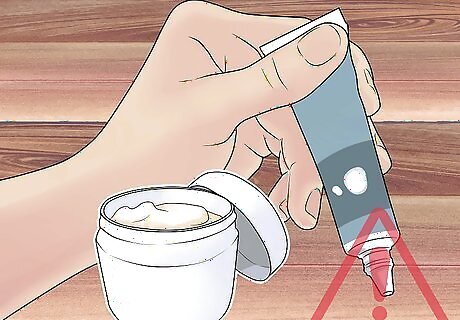
Be cautious when using denture adhesive. There is no benefit to using more than the recommended amount of denture adhesive. Using more will not improve the hold, so follow the instructions on the label or the directions from your dentist. Also, do not use adhesive more than once per day. Finally, adhesive is not to be used as a substitute for poorly fitting dentures. If you are concerned about the fit of your dentures, book a visit with your dentist as soon as you can. When you no longer have your teeth, your jaw bone will dissolve over time. This will cause the fit of your dentures to change as well as they lack the support of the jaw bone.


















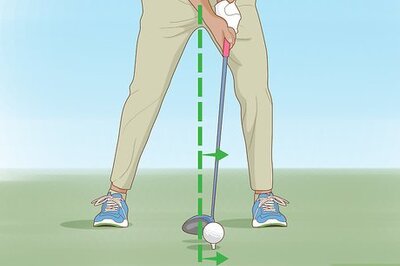
Comments
0 comment